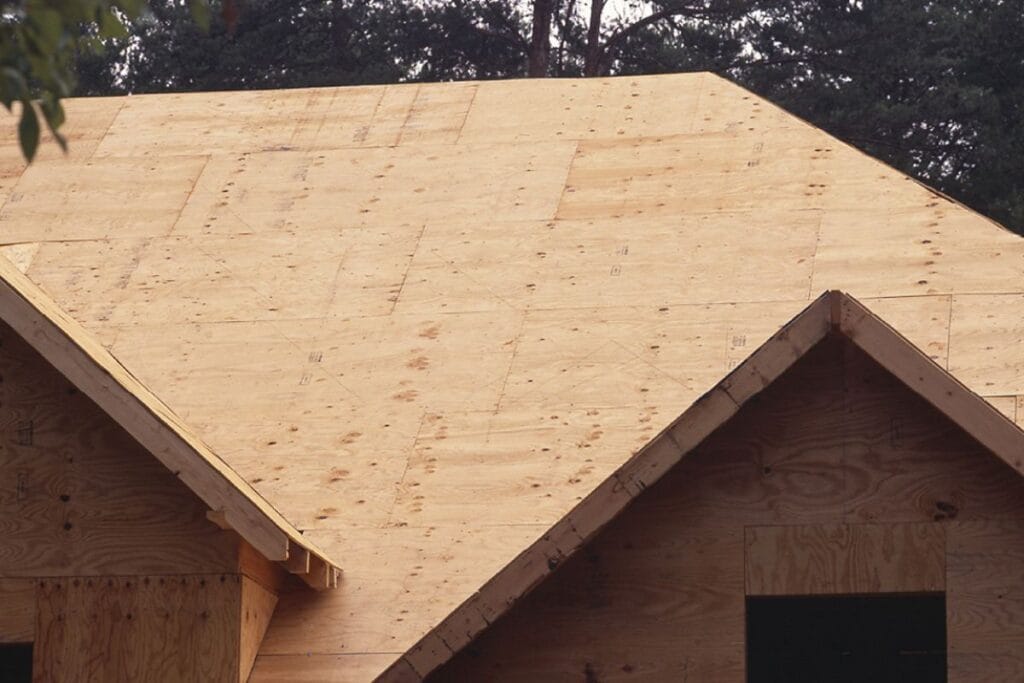As a seasoned professional in the roofing and construction industry, I have witnessed firsthand the crucial role that roof decking plays in the structural integrity and longevity of a building.
Roof decking forms a solid foundation upon which the rest of the roofing system relies. In this blog post, I’ll explain everything about roof decks, providing you with the knowledge you need to understand the significance, types, code compliance, and installation specifics of this roofing component.
Roof Decking: The Foundation of Your Roof
When it comes to constructing a solid and durable roof, preparing a strong foundation is key. This is where a roof deck comes into play. The roof deck, sometimes referred to as roof sheathing, is the material that covers the roof’s trusses or rafters, forming the structural base upon which the rest of the roofing components will lie.
The Role & Importance Of Roof Sheathing
A roof deck is a critical element of your roof, and understanding its importance is the first step to ensuring your roof’s long-term performance.
1. Structural Support
Decking provides essential structural support, helping to distribute the weight of the roofing materials and any loads, such as snow or wind, evenly. This is vital for maintaining the integrity of your roof over time.
2. Insulation and Weather Barrier
Roof sheathing can serve as an additional layer of insulation and a barrier against the elements. It keeps your home or building cozy by preventing heat loss while protecting against water intrusion.
3. Roofing Material Attachment
The roof deck is the platform to which roofing materials, like underlayment, shingles, tiles, or metal panels, are securely attached. A solid, even surface is necessary to ensure a uniform and watertight roofing system.
Decking comes in various materials, thicknesses, and qualities. Roofers consider factors such as the home’s age, chosen roofing material, local climate, and building codes for decking material.
Roof Decking Materials
Wood is the most common material used to manufacture roof decks in the United States. Steel decks are also used in buildings, apartments, and properties with metal roofs.
1. Plywood Planks

Plywood is a popular decking material due to its durability and ease of installation. It is made by gluing thin layers of wood veneer together, creating a sturdy and uniform surface. Plywood comes in different grades, with higher grades being more water-resistant and suitable for roofing applications.
2. OSB (Oriented Strand Board)

OSB is another commonly used roof deck material. It consists of compressed wood strands, making it cost-effective and robust. OSB is engineered to resist moisture, which makes it a reliable choice for roofs in humid or wet climates.
3. Tongue and Groove Wooden Decking

Tongue and groove decking is often found in older homes and is characterized by individual boards that interlock. This type of decking provides a tight, secure fit, which can enhance the structural integrity of your roof. It is particularly suitable for roofs with exposed rafters.
4. Metal Roof Deck
For commercial and industrial buildings, metal decks are the go-to choice. It’s made from steel and serves the dual purpose of supporting the roofing materials and providing a fire-resistant surface. However, metal decking is usually only ideal for flat and low-slope roofs.
Now, let’s understand the dimensions of decking material.
Decking Material Dimensions
Choosing the right thickness and size for the roof deck boards is essential for building a solid deck that can handle the heavy loads of subsequent roofing materials, snow, wind, and other elements.
Thickness
Thicker decking provides more structural support and durability. Common thicknesses for plywood and OSB range from 3/8 inch to 3/4 inch. Thicker decking is typically preferred for areas with heavy snow loads or where the roof’s structure requires additional strength.
Size
Standard dimensions for plywood and OSB sheets are 4 feet by 8 feet, but larger sizes may be available. These larger sheets can reduce the number of boards and seams in your roof deck, which can help prevent leaks and save money on materials. Tongue and groove boards are built with a more custom approach.
Here are a few tips on picking the right type of roof deck boards:
👉 If you have trusses or rafters with broader spacing, you may need thicker and larger boards to distribute the load evenly.
👉 Steeper roofs may require additional support and thicker roof deck boards to prevent sagging or deformation over time.
👉 Regions with heavy snowfall or frequent rain may benefit from thicker and more water-resistant roof sheathing materials.
👉Thicker and larger boards may cost more, but they can offer greater durability and longevity.
Now that you are familiar with the role and material requirements for roof decks, let’s move on to the installation requirements.
Roof Decking Installation Requirements
Proper installation of a roof deck is crucial for the long-term performance of your roofing system. Here’s an in-depth look at the critical installation requirements to ensure a solid foundation for your roof:
Spacing
The first step in the installation process is to ensure that the roof trusses or rafters are properly spaced to accommodate the chosen decking material. Adequate spacing ensures that the roof deck can adequately distribute the weight of roofing materials and other loads. The recommended spacing will depend on the material’s thickness and the local building codes, so consult these guidelines closely.
Fasteners
Proper fastening is essential to prevent the boards from shifting or loosening over time. Use appropriate fastening material and size to secure the deck to the roof structure. The nails or screws should be made of a corrosion resistant metal and their size should not be smaller or larger than the required dimensions. The type, length, and spacing of the fasteners should comply with the manufacturer’s recommendations and local building codes.
Overlapping
Overlap the decking sheets or boards correctly to create a continuous and solid surface. This prevents gaps that could allow water infiltration and ensures a consistent base for your roofing materials.
Orientation
Install the sheathing material with the grain running perpendicular to the roof trusses or rafters. This orientation enhances the structural integrity of the roof, ensuring that it can bear the weight of the roofing materials and external loads.
Edge Support
Strengthening the edges of the roof decking prevents sagging and ensures the roof’s stability over time. Provide additional support along the edges to ensure it can withstand any loads applied at the roof’s perimeter. This is particularly important for areas where gutters or snow guards are installed.
Ventilation
Adequate roof ventilation helps preserve the integrity of the sheathing and prevents issues like rot and mold. It is also essential for the longevity of the entire roofing system. Install roof and attic vent systems as required by local building codes.
Compliance With Local Building Codes
Following local roofing codes is vital not only for safety but also for avoiding legal and insurance issues. Always ensure that your installation complies with local building codes and regulations. Building codes can vary by location, so it’s crucial to consult with a good roof inspector or to ensure that your installation adheres to the specific requirements in your area.
Professional Installation
Roofing experts possess the necessary knowledge and tools to ensure a proper installation that meets all safety and quality standards. Professional installation also provides peace of mind, knowing that the job is finished correctly, minimizing the risk of damage and future issues.
By paying close attention to these installation requirements, you can ensure that the roof deck serves as a solid and reliable foundation for your roofing system. This meticulous approach contributes to the long-term performance and durability of your roof, ultimately protecting your home’s structure from stress and damage.
If you want to understand the other crucial parts of a roof, or need professional help with your roofing project, our roofing experts are always available for a call.
Schedule A Free Roof Consultation With The Experts
At ReNew Roofing, we are proud to have a large team of skilled and reliable experts with substantial experience. As a GAF Master Elite® contractor, we have the knowledge and expertise to guide you in any kind of roofing project. If you are building a new roof deck or need roof replacement service in Wisconsin, Minnesota or Missouri, call us at (833) 715-7663. One of our roofing experts will be happy to answer all your questions during a free consultation.
FAQ
A. Roofing materials suitable for use as a roof deck include wood, metal and concrete, depending on if a decking is needed for residential or commercial applications. These materials can withstand different levels of foot traffic, and weight.
A. The most common type of roof deck is oriented strand board (OSB). OSB is widely used in construction due to its affordability, strength, and resistance to moisture. It consists of compressed strands of wood and offers a sturdy and reliable surface for supporting roofing materials.
A. After the rood deck is installed, felt or synthetic underlayment is installed on top as well as an ice and water shield. This underlayment acts as a secondary barrier against moisture and provides additional protection for the roof deck.






